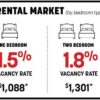After more than 30 years in the real estate business, Cuckoo Kochar doesn’t get fazed by much.
But even the founder of Phoenix Homes is raising his eyebrows at the dramatic spike in apartment rents in the National Capital Region over the past couple of years.
“This is Toronto territory,” he says, referring to the rents of up to $3 a square foot that high-end units in the city’s central core are now fetching. “We never thought Ottawa would get up there, but it did.”
(Sponsored)

Invest with confidence: Hydro Ottawa funds technical studies for business retrofits
For Ottawa businesses, the opportunity to improve building performance has never been greater. Energy retrofits can cut emissions, strengthen operations, extend the life of assets, reduce operating costs, and position

Invest with confidence: Hydro Ottawa funds technical studies for business retrofits
For Ottawa businesses, the opportunity to improve building performance has never been greater. Energy retrofits can cut emissions, strengthen operations, extend the life of assets, reduce operating costs, and position
In a coincidence the veteran property developer could probably appreciate, on the same mid-December day Kochar spoke to OBJ, apartment rental search website PadMapper released a year-end report that dramatically illustrated his point.
One of the study’s key findings: although Ottawa ranked seventh among major Canadian cities in median rents for one- and two-bedroom apartments in 2019, it saw the third-highest year-over-year increase in one-bedroom rents at 15.2 per cent.
The median price of a one-bedroom flat in Ottawa now stands at $1,440, with a two-bedroom unit going for $1,790 – up 14.7 per cent over 2018.

And Kochar says any would-be tenants hoping the market will cool off in 2020 are going to be sorely disappointed.
“The demand for rentals is just not ending,” he says. “It’s just not gonna happen.”
Real estate experts say the capital’s frothy rental market can be attributed to a number of factors.
A region with a booming tech scene and an unemployment rate below five per cent is drawing an influx of well-paid itinerant workers who prefer to rent rather than buy, they note. Meanwhile, more and more aging empty-nesters are selling their homes and opting to move into apartment buildings, where a growing number of their neighbours are millennials who can’t afford the down payment for a home in the capital’s equally robust housing market.
“Which young couple has $25,000 in savings?” Kochar asks. “It just isn’t there. What choice do they have? They’ll go and rent.”
With all those groups now vying for space in an apartment universe that’s grown by only a few thousand units over the past two decades, it’s no wonder many apartment buildings are practically bursting at the seams.
Ottawa’s rental vacancy rate, which sat at 1.6 per cent last year, is expected to remain below two per cent until at least 2022, according to a recent report from the Canada Mortgage and Housing Corp.
“This has been a slow burn to the point where it’s becoming a real issue in terms of availability,” explains Hugh Gorman, CEO of Ottawa-based real estate investment and management firm Colonnade BridgePort. “There’s going to need to be some significant new supply to kind of deal with the pent-up demand.”
Now, Ottawa’s builders are in overdrive trying to make up for lost time. Developers launched nearly 2,300 new apartment starts in 2019 through the end of November, CMHC says, following a 2018 that saw them begin work on almost 2,500 new units.


The capital hasn’t seen a frenzy of new apartment construction like that in decades, but many industry veterans say they don’t see any slowdown in sight for the foreseeable future.
Even the addition of a couple thousand units to the city’s stock of roughly 70,000 purpose-built apartments still equates to a bump of less than two per cent, notes Burlington-based rental industry consultant Derek Lobo. And that’s not counting the tens of thousands of households in the so-called “shadow market” that are renting investment condos or basement apartments in houses, he adds.
“By national standards, Ottawa is not overbuilt,” says Lobo, whose brokerage, SVN Rock Advisors, has worked with a number of builders on local rental projects. “There’s room for a lot more buildings.”
Still, adding to the city’s apartment stock requires a bit of a balancing act on the part of developers.
It takes time for tenants to relocate from existing units, meaning builders are constantly trying to ensure they’re rolling out enough new inventory to meet demand while at the same time guarding against flooding the market with too much new product all at once.
In addition, the entire construction cycle, from initial public consultations to rezoning approvals to ultimate completion, often takes four years or more. Market conditions can change significantly in that length of time.
Developers keep a close watch on other companies’ projects and employ teams of analysts who constantly monitor trends such as population growth, job creation, income levels, transit ridership and changes in a city’s demographics, explains Fred Waks, CEO of Trinity Development Group.
Ottawa’s apartment vacancy rate
10-year average:
2.21%
Five-year average:
2.72%
2018:
1.60%
Source: CMHC
Trinity’s analysts have been busy lately – the Toronto-based builder currently has more than 2,300 units under construction or planned for a handful of sites in the nation’s capital, mostly near stations on the new Confederation light-rail line and the soon-to-be-expanded Trillium Line. The crown jewel of the bunch is 900 Albert St., where Trinity expects to break ground this spring on three mixed-use highrises that will feature about 1,300 rental units. Waks is confident the project’s prime location steps away from the junction of the city’s two LRT lines will make it a hit with tenants.
“That’s our biggest exposure, and I’m not worried about it,” he says. “I think that as in all real estate, the best location’s a win in terms of absorption. I would say to you that 900 Albert is the best location in Ottawa for what we’re doing.”
Waks says Trinity is being careful to phase in its developments over a period of several years.
Next in the queue after 900 Albert will be a 745-unit apartment complex a few hundred metres south at the corner of Gladstone and Loretta avenues, near the future Gladstone LRT station. That project likely won’t get going for at least a couple more years, he says.
“If I was to bring out Loretta and Gladstone at the exact same time as 900 (Albert), that would be a foolish endeavour,” Waks says. “You have to manage absorption.”
Gorman, whose firm has two new buildings set to open in Hintonburg and Westboro this year as well as five more projects in its development pipeline, agrees.
“Ottawa is not a market where you build 800 or a thousand units at once,” he says. “You’re always worried about the supply side and throwing the market out of equilibrium. We’re always trying to make sure that we try and get out in front of the curve in terms of development in specific nodes.”
Gorman says knowing when to pull the trigger on a new project is always a bit of a guessing game. Success is never a sure thing, and even a plan that seems like a slam-dunk today could end up on the back burner tomorrow if the economy tanks or financing falls through.
“Certainly, we’re always watching that supply,” he says. “It’s our hope that everybody else is too. It’s not a perfect science by any stretch of the imagination. There’s lots of projects that may or may not get built. Even though people are going through a rezoning process, it doesn’t necessarily mean that they’re going to construct. It’s something that we pay extremely close attention to.”
Most builders, however, believe new rental projects will continue to flourish well into the next decade.
Claridge Homes vice-president Neil Malhotra agrees with many of his industry colleagues in arguing that the market is still “underserved.” His family-owned company is planning to build about 1,200 apartment units at several locations in the downtown core over the next four to five years, a schedule he says he’s comfortable with.
“This is stuff we’ve been working on for years,” he notes. “What does the future look like? I don’t know if anyone can say we’re going to see thousands and thousands of units built every year. There’s an immediate need, and the market will at some point reach that equilibrium. Is it in the next year or two? No, because things are a little crazy out there right now on the demand side, and it takes a long time to get these things up and running.”
“Things are a little crazy out there right now on the demand side, and it takes a long time to get these things up and running.”
Claridge Homes vice-president Neil Malhotra
But the construction boom has downsides for builders too. A scarcity of development-ready land has driven up prices from about $20 a square foot two or three years ago to around $60 today. Meanwhile, labour costs have jumped nearly 25 per cent over that span due to a shortage of skilled tradespeople.
“Every line item adds up to something,” Waks says.
Still, finding partners willing to help foot the bill for new projects might be easier than ever, industry insiders say. Institutional investors such as pension funds view apartment buildings as ideal vehicles for stable, long-term returns, and many of them are more than happy to grab a stake in such projects.
“As an asset class, it’s kind of the golden child right now,” Gorman says. “From the equity side, there’s lots of capital flowing into the market.
“That’s a bit of a concern for us, to be totally blunt,” he adds, explaining that “too much inexpensive capital flowing into the market without a ton of discipline” can eventually lead to overbuilding and a glut of inventory.
Undaunted, Lobo says the city’s rental universe still has plenty of room to grow.
“It’s not like Ottawa has too many apartments already,” he reiterates. “On top of that, you add some of the strongest income in Canada, strong job growth, strong employment, low vacancy. Ottawa’s attractive.”
Rental density by market (2018)
Apartment units per 100 people:
- Montreal: 24.8
- Halifax: 14.9
- Toronto: 9.7
- Vancouver: 9.1
- Winnipeg: 8.4
- Ottawa: 7.4
- Edmonton: 6.7
- Regina: 6.2
- Calgary: 3.1
- St. John’s: 1.7
Source: SVN Rock Advisors




